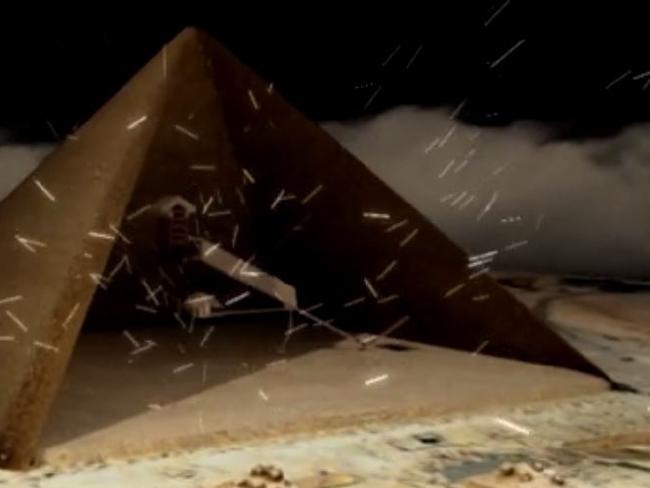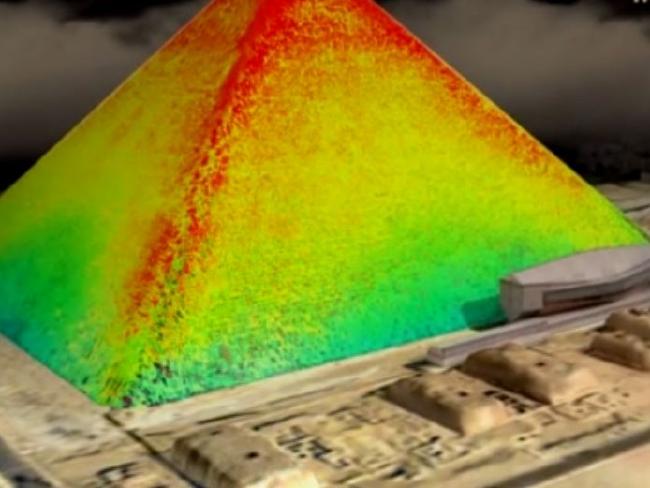
Seen in a new light ... A year-long survey aims to peer deep into the heart of the pyramids to learn the secrets of their construction. Source: AP
HOW can cosmic rays help archaeologists peer through stone deep into the heart of a pyramid? It takes power on an intergalactic scale — and the ghostly impressions these particles leave behind.
Late last month the Egyptian Ministry of Antiquities announced it will be conducting an extensive, high-tech survey of several key pyramids in an effort to better understand how they were built.
Then there’s the enticing idea of discovering hidden chambers.
So how do cosmic rays play a part in the Scan Pyramids mission?

Ghost particles ... Short-lived muons, created from the impact of cosmic rays with our atmosphere, can pass deep through rock before being absorbed.
“Cosmic rays produce muons when they hit the atmosphere,” says Swinburne University astrophysicist Dr Alan Duffy. “It works just like a doctor would X-ray your arm where the bone blocks the X-rays leaving a shadow on the film print and you see a broken arm because X-rays fly through the bit where the bone should be.”
In the case of the pyramids, such a break would be a chamber. Or a passage.
And instead of artificial X-rays, it’s naturally-produced muons.
It’s been done before.
It’s been used to look inside volcanoes. It’s been used to peer into chaos of Fukushima’s damaged nuclear reactors.
It’s just that the technology has advanced considerably since it was first used 40 years ago to survey the Second Pyramid of Chephren.
Now, muons will be used to peer deep into Khufu and Khafre’s pyramids on the Giza plateau, and the Bent and Red pyramids at Dahshur.
The year-long project kicks off this month.

Ghost hunting ... A muon sensor placed in a pyramid’s burial chamber can detect the muons which flash through it — allowing physicists to extrapolate the direction from which it came and what speed it was moving.
MUONS IN MOTION
Cosmic rays are some of the most energetic particles known, sped up to near light-speed by exploding stars or blockholes, says Dr Duffy.
These then travel trillions of kilometres through space before slamming into the Earth’s atmosphere.
“When a cosmic ray crashes into our atmosphere it can produce a heavier cousin of the electron, called a muon, which can fly through tens of metres of rock before finally stopping,” Dr Duffy says.
More than 600 of these particles ran down through your body every minute, with no effect.
But they do react with certain types of gas — causing them leave a briefly glowing trail.
These trails can be captured, and measured to reveal how energetic the muon was.
“This makes them perfect to image the inside of a pyramid by placing a muon detector in the middle of it and watching what makes it through the rock,” Dr Duffy says.
The patterns imprinted on the muon sensor tells a tale that can be extrapolated into a 3D image of a structure.
“In a pyramids the walls will block most of the particles from space but if we see more streaming in through from a certain direction we know that there’s a ‘break’ in the wall. This may mean there is a secret chamber in that direction.”
However, it’s not a process that will produce an X-ray image within minutes.
It likely take most of the year-long duration of the project for a muon detector to build up a picture of a pyramid’s interior.

Getting warmer ... Variations in temperature revealed by infra-red scans can provide clues of everything from cavities through to how much weight a rock is bearing.
SENSOR SUITE
The movements of muons aren’t the only new tool being used in this latest survey of Egypt’s key pyramids.
Ground penetrating radar again be used to send pulses of energy deep into the rock and measure how it is reflected back. Discrepancies in the timing of each return pulse will be produced by any voids it may hit. Then there’s the way different substances — such as metals — can reflect more.
The pyramids will also be electrified.
Electrical-resistivity probes with tap into the structures’ electrical flows. Differing types of stone and brick produce different results.
Lasers will be projected to map the position and characteristics of every block. Thermal imaging will seek out any odd changes of temperature on the surface and internal walls of each structure.
Then there will be the drones scouring the countryside, further adding to the mass of imagery recording the pyramids themselves and the terrain surrounding them.
But none of these offer the same potential to take as broad and deep an image of the insides of a pyramid as a muon detector.













